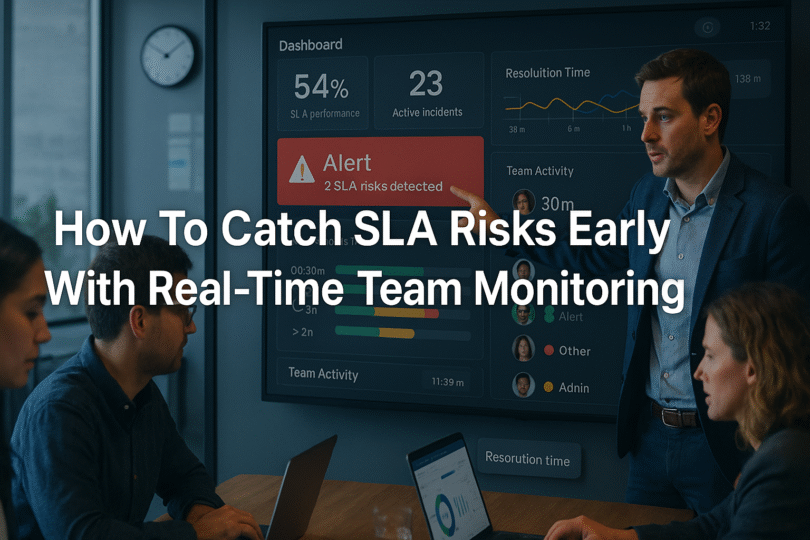Published on July 23rd, 2025
When teams work across shifts and locations, performance can slip without warning. You don’t see where focus drops or where time goes until the numbers come in too late to fix the damage.
That blind spot leads to missed SLAs, uneven workloads, and hours lost to preventable delays.
This article explores how real-time visibility helps you catch performance risks before they derail SLAs. A tool for tracking productivity for remote workers gives you live visibility to keep your team consistent, focused, and accountable.
What You Can’t See Is Already Slowing Your Team Down
It’s nearly impossible to stay on top of your team’s work without real-time visibility. You only see the impact later, when KPIs slip and client expectations are already at risk.
These are the friction points that surface first when you’re managing remote and hybrid teams without live oversight:
- Missed Signals: Bottlenecks and idle time drag KPIs down long before you can act.
- Uneven Workloads: Some team members do too much work while others do too little, which hurts the whole team.
- Late Interventions: Feedback comes too late, after mistakes happen more than once.
- Client Doubts: Without clear proof of work, trust erodes and escalations follow.
Read More: How Can Managers Support Their Teams Remotely
How to Catch SLA Risks Early and Keep Teams On Track
Without real-time visibility, SLA risks build up before you notice. Monitoring tools help you spot problems early and fix them before they hurt client commitments and team output.
Here’s how to close visibility gaps and keep your team aligned with real-time monitoring:
1. Stay Ahead With Live Activity Dashboards
Live dashboards let you see who is working, what they are doing, and how tasks progress in real time. You do not have to wait for end-of-day reports to spot issues. You catch and fix problems the moment they appear.
This matters most when managing remote or overnight shifts. Without visibility, small issues like late logins or agents stuck on tasks drag down KPIs unnoticed. A live view lets you spot these slowdowns early and keep performance steady.
Start each shift by checking attendance and activity. Use what you see to rebalance workloads, focus on priority tasks, and step in quickly when performance dips.
How can a virtual workforce productivity engine enhance real-time visibility?
A virtual workforce productivity engine gives you live dashboards that show who is working and what they’re doing. When several agents stop making calls during a busy time, you can quickly move other team members to cover and prevent long wait times.
2. Build Accountability Through Transparent Reporting
Accountability is strongest when everyone has access to the same data. Transparent reporting removes doubt about who is doing the work and how time is spent. It also helps team members understand how their activity affects results.
This approach is especially useful during client escalations. When you can show accurate logs and activity reports, it builds trust and protects you from disputes over billing or SLA adherence.
Remote and hybrid teams also perform better when they know their efforts are visible.
Research shows that when you build on people’s strengths, engagement goes up by 9% to 15%. This helps teams stay motivated and take responsibility for their work.
Start by sharing shift reports and activity summaries with your team. Use them to highlight wins, address disengagement early, and make expectations clear. Sharing this data creates a shared sense of ownership across the group.
How can a remote job tracking tool reinforce accountability?
A remote job tracking tool turns raw activity into clear reports. Seeing that an agent consistently misses deadlines on certain tasks lets you provide targeted coaching to improve their workflow and keep the team on track.
Read More: What to consider when choosing a dedicated development partner
3. Coach Smarter With Real-Time Alerts
Coaching only works when you catch issues early. Waiting until weekly reviews means mistakes happen again and again before you step in. Real-time alerts let you fix problems as they happen and guide your team while work is still underway.
Alerts flag agents who spend too much time idle, miss logins, or work too long and risk burnout. You can adjust workloads, jump in with support, or coach quickly where it counts most.
Set alerts for key metrics like occupancy, app use, and breaks. Use those alerts to have quick check-ins that keep your team focused, without watching over them all day.
How can a virtual team oversight platform enable proactive coaching?
A virtual team oversight platform sends instant alerts when risky patterns appear, like long idle times or excessive after-call work.
Receiving a notification about an agent’s repeated late logins allows you to address the issue immediately and help them adjust their schedule before it affects overall team performance.
4. Strengthen Client Confidence With Proof-of-Work Data
Clients need proof that your team is delivering as promised. Transparent reports remove doubts and keep relationships strong.
Activity logs and shift reports show exactly how your team spends work hours. You can prove productivity and SLA compliance with data that matches client expectations. This also stops billing disputes before they start.
Send client-ready reports that highlight utilization, active hours, and schedule adherence. Sharing these regularly builds trust and shows you’re a reliable partner.
How can workforce intelligence platforms improve client trust?
Insightful workforce intelligence platform creates detailed reports that show team effort and adherence.
Access to these reports lets you quickly address client concerns about missed targets, helping you secure contract renewals with clear, data-backed proof of consistent performance.
Read More: How To Organize Your Team For A Successful Corporate Event
5. Prevent SLA Risks in Real Time With Smart Tools
A monitoring tool gives you real-time clarity and clear reports so you can spot risks fast and keep your team hitting SLAs without guesswork.
Here is how a monitoring tool helps you close visibility gaps and keep your team on track:
- Live Dashboards: Spot active and idle time instantly to redirect focus as needed.
- Shift-Based Tracking: Monitor distributed teams across time zones with precision.
- Real-Time Alerts: Act on early warning signs to prevent KPI dips.
- Client-Ready Reports: Provide clear proof of work to strengthen client confidence.
Conclusion
Closing visibility gaps helps your remote and hybrid teams stay focused and consistent across every shift.
Monitoring tools embed real-time awareness into daily workflows so accountability becomes effortless. With live insights, you can keep performance high and build stronger client relationships.







